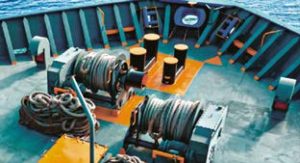The Charity
Aviation
Maritime
M1878

Initial Report
Initial report
The reporter informed CHIRP that a tanker was approaching the berth under pilotage with the assistance of tugs. The forward tug was to be released from the tanker’s bow prior to the vessel turning to starboard. The eye of the towing line was secured to the bitts on the forecastle and had a long messenger rope attached to it. The tug’s line was slackened to facilitate its release.
An ordinary seaman (OS) eased the tug’s mooring rope out through the closed chock (Panama lead) and had taken a turn of the messenger rope around the bitts. As the tanker turned to starboard to align itself with the berth the tug’s line was in the water and as the separation between the tanker’s bow and the tug increased, the messenger line paid out at an increased speed which was not anticipated by the line handlers.
The officer in charge of the mooring operation warned the OS to step clear from the messenger rope. The OS attempted to do so but slipped on the deck and became entangled with the rope which dragged him overboard through the Panama chock. The OS was recovered from the water by the tug and resuscitation and first aid was immediately administered until the ambulance took them to hospital. Tragically the OS died the next day.

CHIRP Comment
This tragedy highlights the risks associated with all types of mooring operations.
Although SMS manuals detail how mooring should be conducted, they may not highlight that handling of mooring lines including messenger lines can quickly get out of control if they are not properly secured against the effects of gravity or the dynamic interaction between the tug and the vessel.
The officer in charge must always try to anticipate changes in the loading on the lines and have the crew stand in a safe position away from any potential danger. A tug’s line and attached messenger should always be recovered on board the tug before it starts moving away.
The forward and aft mooring decks on any ship are classified as high risk zones and have associated risks during mooring operations. The management of the mooring lines requires a very high level of attention by the crew handling the lines as well as the officer responsible for the mooring operation.
A full safety brief should always take place before mooring operations commence, including clear instructions to be followed in normal and emergency scenarios. Mooring operations must never be rushed as this can lead to actions being taken which are not thought out clearly. In this case the OS slipped and fell while attempting to get to a safer location, which tragically led to their death.
Human Factors relating to this report
Situational Awareness – Mooring operations can evolve rapidly and maintaining situational awareness during mooring operations is vital to ensure that everyone remains safe. Anticipation is key: lines can unexpectedly become taut or even break, creating a lethal snap-back hazard; winch brakes can fail or ropes be pulled overboard due to the relative motion of the vessel and the tug or bollard ashore.
Teamwork – This tragedy appears to show that the OS operated alone while handling the tug’s line? How many crew do you think should have been handling this tugs line?
Capability – A high degree of seamanship skill is required during mooring operations. During your mooring operations do you always have the right level of competence to carry out safe mooring operations? If you do not, have you raised this matter with management?
Report Ends…………..







